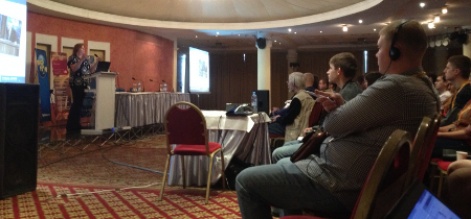The increasing prevalence at which Facebook and even Twitter plug themselves into mobile titles means we tend to throw around the term "social" rather loosely these days.
But merely integrating social networks into play doesn't make the game in question truly social.
As Kimberley Blake, founder and CMO of consulting firm Gemini Hive puts it during her talk at Casual Connect in Kiev, "you can call it a dance all you want, but if no one's dancing, it's not a dance."
So what can developers do to make sure their players are really involved in the dance and not just idly tapping their feet to the beat on the sidelines?
All about atmosphere
Sticking with the school dance analogy, Blake explains that you have to find a good-sized hall, get a stereo system, find a DJ, install a disco ball and turn down the lights before you can invite anyone to your event and call it a dance.
The same goes for a healthy community: they need the tools to communicate with one another in the ways that they want to create a frictionless social experience. As soon as you have all this and you open the doors, the dancing is bound to begin.
Kimberley Blake on stage in Kiev

But using social platforms is also a question of authenticity of ensuring that what you say on social networks is true and honest to what your game is.
When making posts to social channels, for example, you should keep in mind what your brand is, and how your customers perceive that brand.
"If your game is about ponies and kittens, don't post about deadly alligators or combat," remarks Blake.
It's an obvious point, but one so many studios and publishers fall down on. Whether through aesthetics, monetisation model, or inherent gameplay design, your game tailors to a specific crowd of player.
So if you're making a game about racing cars, posting facts about the cars in your game is relevant content, but getting all Heat Magazine and posting about the celebrity wives of the drivers of those cars, might not be quite so interesting to your audience.
Or maybe it will: you know your audience better than anyone, so tailor your content to them.
Dialogue detail
Indeed, fostering a relationship with your players and encouraging a conversation is a perfect way to keep your title in their hearts and minds argues Blake, but you have to be the spark to start that somewhere, and you need to tailor your content to encourage this interactivity.
As such, rather than say simple posting on Twitter that there is "now an update available for Fluffy Bunny Adventures," asking questions of your fanbase such as "Has everyone updated Fluffy Bunny Adventures yet? How many of the Carrot Chase Time Trials have you beaten?" - is likely to prove far more engaging.
According to Blake, players don't want to talks about your products, they want to talk about "the experiences around your products".
She cited a conference at which King put several of their most hardcore players on a stage and invited the crowd to ask questions.
"Why do you play?", "when do you play?", "do you like spending money?" all received a tepid response and conversations died out quickly, but when one of the panel noted that "I reached level 430 in Candy Crush Saga", suddenly the dialogue rapidly increased in pace.
It's something people can relate to, something for people to talk about, and though it's absolutely increasing the virality of your product when it's done online, it just feels like a natural conversation for those taking part.
Nurture your relationships
On a similar note, it's all too easy to come across as a salesman when you speak with customers, as your end goal is always, ultimately, going to be to increase sales from them. As Blake notes, if you're on Facebook with your product, then "you are in direct marketing".
But just because you want a return from the effort you put in, that doesn't mean that the value proposition for users should be a one-way street. Blake stresses that she believes that "70 percent of content put into a community should add value".
This could be an upload of a new piece of art direct from the art team, or it could be a tips and tricks feature for how to beat a particularly tough level, or any number of other types of content that your users will value as being useful or entertaining.
But what of the other 30 percent? "20 percent should be shared content," she continues, highlighting content when you push forward the best voices in your community.
For example, perhaps one of your super fans has written a piece of fan fiction on their blog, or maybe they've made a tutorial video on YouTube. Whatever it is, you should be showing it off to your other users and rewarding the ones that love your products the most.
Just 10 percdnt of it should be promotional content, and it's here that you extract value from the relationships you've built.
"Only when you feel that the majority of your community is engaged, should you extract," Blake asserts, highlighting that timing is everything from getting the most return from your users.
Perhaps everyone's been taking part in a competition to win prizes: during or immediately after the competition has ended is the time to highlight a new product range, for example.
If you're still unclear, Blake offers this key analogy;
"If I kept coming up to you and asking for a dollar, and that's all I did, you wouldn't be inclined to give me that dollar," she concludes.
"But say we're friends out shopping, and we've gone to lunch and hung out, and then we're in a store and I'm a little short for something I'd like to buy, and then I ask for a dollar, you're way more likely to give it to me."
Measure and optimise
How do you know if your efforts to engage are worthwhile, however? Measuring the response of your audience is key, though Blake points out the first question here is "what do you measure?" Only you can decide which metrics mean the most to you.
Are you after raw number of Likes on a fan page? How often users respond to your tweets? How many people click through on a link you post? Whatever it is you want, you need to start gathering that data, and measuring how well you're succeeding at doing so, especially when you experiment and try a new approach.
But perhaps the biggest question is not what you want them to do and how often they're doing it, but rather, as Blake comes to the close of her talk, "what does your community want to?".
It's easier, as she points out, to help your audience continue to engage with your content, rather than force them into interacting in the way that you want them to.
Understanding what your users are doing, how they're doing it, and measuring these interactions so that you can help them do more of it, is key to a healthy social life for your products.






















